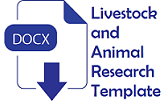Economic regional of beef cattle development Ciamis Regency
Abstract
Objective: 1) To identify priority areas with Ciamis Regency that have comparative and competitive advantages 2) Availability of forages in prime priority areas.
Methods: The material used cattle population data from BPS Ciamis Regency from 2016–2020. Panel data, which combines secondary data and cross-section data, were employed in this study. First, data analysis uses LQ and shift-share analysis, and two, it uses the carrying capacity of forage availability and the carrying capacity index.
Results: Regional economic research results show that six sub-districts provide a comparative and competitive basis for superior commodities, namely Banjarsari, Lakbok, Cijeunjing, Cisaga, Rajadesa, and Baregbeg. These five sub-districts (Cimaragas, Sukadana, Panjalu, Panumbangan, and Sindangkasih) cannot be a base for cattle commodities but can be used as a base for other livestock. The study's findings indicate that forage is available, and the carrying capacity index forage availability has an IDD value of>2 SAFE. The Ciamis Regency has a secure green supply for expanding herds of beef cattle and can even export to other areas.
Conclusions: The local government of Ciamis Regency must consider these six sub-districts an excellent commodity base, comparatively and competitively, with the carrying capacity of forage in safe conditions. The local government of Ciamis Regency must increase the number of livestock populations not only in production but also start opening up potential and conservative land for the development of grass cultivation, for example, by utilizing forest land for grass cultivation.
Keywords
Full Text:
PDFReferences
- Klavon, K. H., S. A. Lansing, W. Mulbry, A. R. Moss, and G. Felton. 2013. Economic analysis of small-scale agricultural digesters in the United States. Biomass Bioenergy. 54:36–45. Doi: 10.1016/j.biombioe.2013.03.009
- Moss, J., P. Morley, D. Baker, and H. Al-Moadhen. 2012. FAO Present trend in livestock population, meat production, slaughter rate and export of meat. Annu. Rep. no. April, p. 82.
- Rouf, A. A., A. Daryanto, and A. Fariyanti. 2014. Daya saing usaha sapi potong di Indonesia: Pendekatan domestic resources cost. Wartazoa. 24(2):97–107. Doi: 10.14334/wartazoa.v24i2.1053
- Suhaema, E., W. Widiatmaka, and Tjahjono, B. 2014. Pengembangan wilayah peternakan sapi potong berbasis kesesuaian fisik lingkungan dan kesesuaian lahan untuk pakan di Kabupaten Cianjur. Jurnal Ilmu Tanah dan Lingkungan. 16(2):53-60. Doi: 10.29244/jitl.16.2.53-60
- Isyanto, A. Y., S. Sudrajat, and D. H. Sujaya. 2018. Pembangunan ekonomi wilayah Kabupaten Ciamis berbasis komoditas peternakan. Mimbar Agribisnis: Jurnal Pemikiran Masyarakat Ilmiah Berwawasan Agribisnis. 4(2):109–120. Doi: 10.25157/Ma.V4i2.899
- Jauhariyah, N. A. and N. Inayah. 2016. Analisis sektor ekonomi unggulan di Kabupaten Banyuwangi. Malia. 8(1):85-98.
- Santoso, B. and B. W. H. E. Prasetiyono. 2020. The regional analysis of beef cattle farm development in Semarang Regency. Tropical Animal Science Journal. 43(1):86–94. Doi: 10.5398/Tasj.2020.43.1.86
- Pratama, A. R., K. Sukiyono, and N. Arianti. 2017. Analisis subsektor pertanian unggulan kabupaten / kota di Provinsi Bengkulu. Agric: Jurnal Ilmu Pertanian. 29(2):21–136. Doi: 10.24246/agric.2017.v29. i2.p121-136
- Ciptayasa, I. N., H. Hermansyah, and M. Yasin. 2016. Analisis potensi ternak kambing di Kabupaten Lombok Barat. Jurnal Ilmu Dan Teknologi Peternakan. Indonesia. 2(1):110–115. Doi: 10.29303/jitpi.v2i1.20
- Mulyono, J. and K. Munibah. 2016. Pendekatan location quotient dan shift share analysis dalam penentuan komoditas unggulan tanaman pangan di Kabupaten Bantul. Jurnal Informatika Pertanian. 25(2):221-230. Doi: 10.21082/ip.v25n2.2016
- Juarini, J., E. Sumanto, I. G. Budiarsana, and B. Wibowo. 2007. Estimasi potensi sumber pakan lokal sapi perah rakyat di Sukabumi. In Seminar Nasional Teknologi Peternakan dan Veteriner. 301–308.
- Yuniar, P. S., W. Widiatmaka, and A. M. Fuah. 2015. Analisis potensi pengembangan peternakan sapi potong di Kota Tangerang Selatan. Jurnal Ilmu Produksi dan Teknologi Hasil Peternakan. 03(2):106–112.
- Yuniar, P. S., A. M. Fuah, and W. Widiatmaka. 2016. Daya dukung dan prioritas wilayah pengembangan ternak sapi potong di Kota Tangerang Selatan. Jurnal Ilmu Produksi dan Teknologi Hasil Peternakan. 4(1):264–268.
- Adinata, Y., D. Pamungkas, N. H. Krishna, and A. Aryogi. 2014. Estimating dynamic cattle population on palm oil plantation area in South Kalimantan Province. Jurnal Sains Dasar. 3(2):183–189. Doi: 10.21831/ jsd.v3i2.4166
- Isyanto, A. Y., and I. Sugianto. 2016. Factors influencing population of beef cattle in Ciamis Regency, West Java Province, Indonesia. Journal of Economics and Sustainable Development. 7(22):34–38.
- Perwitasari, F. D., A. R. S. Putra, B. Suwignyo, and R. Widiati. 2021. Analysis of the potential of beef cattle business development in Indramayu district. Animal Production. 23(32):127–137. Doi: 10.20884/1.jap.2021.23.2.86
- Agus, A. 2015. Ruminant nutrition: The role of agricultural by products in beef cattle production. Proceeding of International Seminar Improving Tropical Animal Production for Food Security, (November). 3–7.
- Indrayani, I., A. Andri, and B. Boyon. 2022. The role of beef cattle in the economic development analysis of livestock subsector in West Sumatera Province. Jurnal Ekonomi Pertanian Dan Agribisnis. 6(4):1416–1426. Doi: 10.21776/Ub.Jepa.2022.006.04.18
- Elly, F. H., P. O. V. Waleleng, I. D. R. Lumenta, and F. N. S. Oroh. 2013. Introduction of forage of cattle in South Minahasa. Pastura, 3(1):5–8.
- Delima, M., A. Karim, and M. Yunus.2015. Kajian potensi produksi hijauan pakan pada lahan eksisting dan potensial untuk meningkatkan populasi ternak ruminansia di Kabupaten Aceh Besar. Jurnal Agripet. 15(1):33–40. Doi: 10.17969/agripet.v15i1.2297
Refbacks
- There are currently no refbacks.










